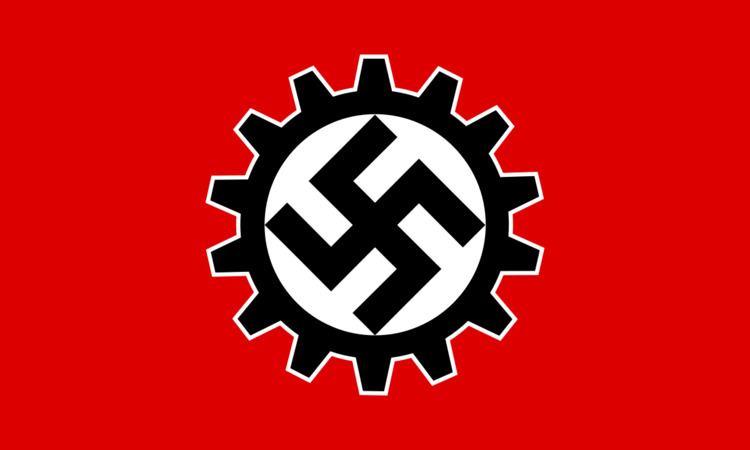 | ||
The German Labour Front (German: Deutsche Arbeitsfront, DAF) was the National Socialist trade union organization which replaced the various independent trade unions of the Weimar Republic after Adolf Hitler's rise to power. After the Nazi-organized 1933 May Day labor celebrations, the Third Reich not only nationalized all trade unions, but decreed union membership as a mandatory duty, forcing every worker to join the state-operated union. This effectively made the DAF a "yellow" union without adequate representation from the membership and bore little resemblance to modern labor practices with free and fair elections. Unlike the conventional premise of unionization, the DAF resulted in lower wages, longer working hours, and little internal representation, often known as union democracy.
Its leader was Robert Ley, who stated its aim was 'to create a true social and productive community' (Smelster, 1988). Theoretically, DAF existed to act as a medium through which workers and owners could mutually represent their interests. Wages were set by the 12 DAF trustees. The employees were given relatively high set wages and security of employment, and dismissal was increasingly made difficult. Social security and leisure programmes were started, canteens, breaks, and regular working times were established, and German workers were generally satisfied by what the DAF gave them in repayment for their absolute loyalty.
Following the National Socialist’s Volksgemeinschaft approach towards developing a greater “people’s community”, the DAF expanded or established new social, educational, sports, health, and entertainment programs for German workers via the Strength through Joy, which included factory libraries and gardens, periodic breaks, swimming pools, low-priced hot meals, adult education programs, periodic work breaks, physical education, sports facilities, gymnastic training, orchestral music during lunch breaks, free tickets to concerts and opera, and subsidized vacations that saw over 10.3 million Germans signed up by 1938. The DAF financed the building of ocean-going vessels that permitted German workers to pay minimal prices to sail to many foreign destinations. Up to six ocean liners were operating just before the start of World War II. According to the chief of the Associated Press in Berlin, Louis P. Lochner, ticket prices for ocean streamer vessels ranged from twelve to sixteen marks for “a full week on such a steamer.” For those who desired vacations closer to home, the DAF constructed spa and summer resort complexes. One of the largest was located on the island of Reugen, where the DAF financed and erected a “summer resort with 20,000 beds.”.
To help financial such ambitious social programs, the DAF also operated one of the largest financial institutions—the Bank of German Labor—along with additional community programs such as medical screening, occupational training, legal assistance and programs to improve the company’s working environment. The DAF was one of the largest National Socialist organizations, boasting of over 35,000 full-time employees by 1939. To help Hitler keep his promise to have every German capable of owning an affordable car (Volkswagen—the People’s Car) the DAF subsidized the construction of an automobile factory, which was partially paid from worker’s payroll deductions. None of the 340,000 workers who were paying for a car ever received one, since the factory had to be retooled for war production after Nazi Germany invaded Poland.
In the case of workplace abuses, the DAF set up worker councils to regulate and manage business practices, along with working hours and wages, and conflicts rising between employers and workers. In 1934, worker councils dismissed over 50 workers, while in the same year 13 employers were punished through the expropriation of their business.
Employment contracts created under the Weimar Republic were abolished and renewed under new circumstances in the DAF. Employers could demand more of their workers, while at the same time workers were given increased security of work and increasingly enrolled into social security programmes for workers. The organisation, by its own definition, combated capitalism and liberalism, but also revolution against the factory owners and the National Socialist state. The DAF, however, did openly prefer to have large companies nationalised by the German state, instead of privately owned companies.
DAF membership was theoretically voluntary, but any workers in any area of German commerce or industry would have found it hard to get a job without being a member. Membership required a fee within the range of 15 pfennig to three Reichsmark, depending on the category a member fell into in a large scale of 20 membership groups. A substantially large amount of income was raised through fees. In 1934, the total intake was 300,000,000 Reichsmark.
There were two main components of the DAF and these were:
Several other sub-organisations were set up:
The Front also organised the Reichsberufswettkampf, a national vocational competition.
